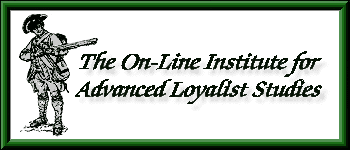

|
 |
|
The history of the King's American Regiment is presented in 8 parts. Click below to skip to:
Part 1 - Introduction & Recruiting a Regiment |
A History of the King's American Regiment - Part 3 of 8 |
|
New York 1777 The early history of the King's American Regiment was one of somewhat mundane garrison and fatigue duty. Their first service was to reinforce the post of Huntington, where they shared the duty with the 3rd Battalion, DeLancey's Brigade.31 No incidents of note occurred during their stay there, and they were moved in June of 1777 to the lines at Kingsbridge. At Kingsbridge they were brigaded with British, Hessian and other Provincial troops, including the Prince of Wales American Volunteers, Independent Companies, 2nd Battalion of DeLancey's and New York Volunteers. Their main duty at Kingsbridge was to contribute to the defense of the northern fortifications of New York and provide working parties for their maintenance. While stationed at Kingsbridge the regiment participated in two major excursions from the British lines. The first was from September 11th — 16th when two hundred Provincials, including many from the KAR, all under the command of Lt. Col. George CAMPBELL, crossed over the Hudson and marched towards Tappan, New York. This movement was part of a several pronged incursion into Bergen County from Staten Island, Paulus Hook, and Fort Lee by Sir Henry CLINTON, commanding officer at New York and environs. The object of the raid was to collect cattle and forage, and in some small way, possibly attract attention away from the main British army operations in Pennsylvania.32 None of the troops under CAMPBELL suffered any losses during the foray.33 The second action was of a much more serious nature. September and October of 1777 were a critical period of the war. The main army under Sir William HOWE had just captured the Rebel capital of Philadelphia while a battered and cut off army under Lt. Genl. John BURGOYNE was fighting for its life above Albany. The British army at New York and environs had a strength of only about 8,000 effective men, many of them Provincials. With a part of this force though, CLINTON wished to make a diversion in favor of BURGOYNE in the hopes of relieving the pressure on him. Taking 3,000 of his men in the beginning of October, CLINTON sailed up the Hudson to attack the river forts Clinton and Montgomery.34 The King's American Regiment and the King's Orange Rangers were landed on the east side of the river, while the remainder of the British, Germans and Provincials landed below and behind the forts on the west side. On October 6, 1777 the British attacked the forts by storm, taking many officers and over two hundred soldiers prisoner.35 The KAR had no direct role in the attack except for those men who were attached to Captain Andreas EMMERICH's Company of Chasseurs. The Chasseurs had been formed at Kingsbridge in late August of 1777 from volunteers from the Provincial Corps stationed there.36 The men were to be active marksmen and were re-equipped with rifles.37 They had a prominent role in the attack on the forts, but the vast majority of troops on the east side of the Hudson were reduced to spectators.38 With the capture of the forts, CLINTON was free to sail up the Hudson as far as he dared to aid BURGOYNE. A large number of troops were re-embarked under General VAUGHAN, but once again the KAR was left out of the fray, staying behind to strengthen the newly captured forts. The entire experience was academic, as soon after, an urgent dispatch arrived from Philadelphia demanding a reinforcement of troops be sent there from the New York garrison. With the loss of these men, CLINTON had no choice but to level the forts and sail everyone back to their former posts around the city. In the end, the expedition did not change the fate of John BURGOYNE or draw troops away from Washington in Pennsylvania. It did provide an opportunity for the officers and men of the KAR to witness a viscous and bloody battle with little danger to themselves. The next time they would not be so fortunate as to escape without loss.
31 The regiment marched to Huntington from their quarters at Jamaica (Queens) in two detachments, the first under Colonel Fanning, the second under Captain Fuge. From the first detachment, three companies were moved on to Oyster Bay from Jericho under Major James Grant. Regimental Orders of 31 May, 1 & 10 June 1777. KAR Orderly Book, CL.
Click here for ---> Regimental History Main Page More King's American Regiment History KAR History:
The On-Line Institute for Advanced Loyalist Studies
|